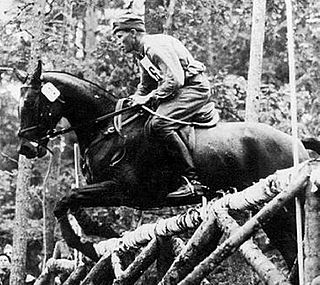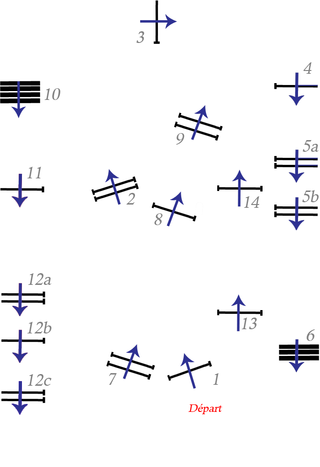
The equestrian program at the 1912 Summer Olympics in Stockholm, included five medal events. There were individual competitions in dressage, eventing, and show jumping. Team scores were also gathered and medals awarded for teams in the eventing and jumping competitions. Equestrian had been absent from the Olympic program since the 1900 Summer Olympics, making the 1912 Games the second time the sport was featured. Ten nations competed: Belgium, Chile, Denmark, France, Germany, Great Britain, Norway, Russia, Sweden, and the USA. Only Sweden and Germany were able to supply a full team for all three disciplines, with several countries having several riders and horses used in two or even all three disciplines. A total of 88 entries ran in the three events, with 62 riders and 70 horses.

The equestrian events at the 1928 Summer Olympics included dressage, eventing, and show jumping. All three disciplines had both individual and team competitions. The competitions were held from 8 to 12 August 1928. Teams were now fielded by three riders, rather than four, the purpose being to reduce pressure on national federations to find that many riders in order to compete for team medals. Riders had to be considered amateurs, which was defined as either an actively serving professional officer, or as a gentleman rider as defined by the rules of that rider's national governing body. A total of 113 entries were present from 20 nations: Argentina, Austria, Belgium, Bulgaria, Czechoslovakia, Denmark, Finland, France, Germany, Hungary, Italy, Japan, the Netherlands, Norway, Poland, Portugal, Spain, Sweden, Switzerland, and the USA. This was the first appearance for Hungary, Japan and Argentina in equestrian events at an Olympics. Additionally, after being shut out from two Olympic competitions, Germany also returned to the Games to win a few medals in the equestrian events.

The equestrian events at the 1936 Berlin Summer Olympics included dressage, eventing, and show jumping. All three disciplines had both individual and team competitions. The host country, Germany, had a stellar year, winning both individual and team gold in every equestrian event, as well as individual silver in dressage. The competitions were held from 12 to 16 August 1936. Moderately priced tickets meant huge crowds at all equestrian events, with 15,000–20,000 spectators at any time during the dressage competition, 60,000 on the endurance day of eventing, and 120,000 for the Nations Cup in jumping.
The equestrian events at the 1956 Summer Olympics were held in Stockholm due to the Australian quarantine regulations and included dressage, eventing, and show jumping. All three disciplines had both individual and team competitions. The competitions were held from 11 to 17 June 1956 at Stockholm Olympic Stadium. There were 158 entries from 29 countries: Argentina, Australia, Austria, Belgium, Brazil, Bulgaria, Cambodia, Canada, Denmark, Egypt, Finland, France, Germany, Great Britain, Hungary, Ireland, Italy, Japan, Netherlands, Norway, Portugal, Romania, Soviet Union, Spain, Sweden, Switzerland, Turkey, USA and Venezuela. This would be the first appearance for Australia, Cambodia and Venezuela in equestrian events.

Venezuela competed at the 1956 Summer Olympics held in Melbourne, Australia, and in the equestrian events held in Stockholm, Sweden. Twenty-two competitors, all men, were selected by the Venezuelan Olympic Committee to take part in sixteen events across five sports. The delegation featured no female competitors, for the second time, and won no medals. While most of the Venezuelan athletes did not advance past the qualifying rounds of their sports, there were some good placings in the shooting, with Germán Briceño and Carlos Monteverde finishing in the top 10 of their events.

Equestrian sports were first included in the Olympic Games in the Summer Olympics of 1900 in Paris. They were again included in 1912, and have been included in every subsequent edition of the Games. The Olympic equestrian disciplines are dressage, eventing, and show-jumping. In each discipline, both individual and team medals are awarded. Women and men compete on equal terms.

The individual show jumping was an equestrian event held as part of the Equestrian at the 1964 Summer Olympics programme. The event was held on 24 October. There were 46 competitors from 17 nations. Each nation could have up to three riders. The event was won by Pierre Jonquères d'Oriola of France, the first rider to win two gold medals in individual jumping; he did so 12 years apart, with his first in 1952. It was France's third gold medal in the event overall, moving out of a tie with Italy at two for most all-time. Hermann Schridde, representing the United Team of Germany, took silver. Great Britain earned its second consecutive bronze in the event, this time with Peter Robeson taking the honors.

The individual show jumping was an equestrian event held as part of the Equestrian at the 1912 Summer Olympics programme. The competition was held on 16 July 1912 as the Stockholm Olympic Stadium. There were 31 competitors from 8 nations. Each nation was limited to a maximum of six riders. The event was won by Jacques Cariou of France, the nation's first victory in the individual jumping. The victory came with a challenge prize presented by Count Gyula Andrássy the Younger of Hungary. Rabod von Kröcher earned Germany's first medal in the event with his silver. Emmanuel de Blommaert of Belgium took bronze.

The individual eventing at the 2008 Summer Olympics took place between August 9 and 12 2008 at the Hong Kong Sports Institute.

The individual show jumping was one of five equestrianism events on the Equestrian at the 1924 Summer Olympics programme. The competition was held on Saturday 27 July 1924. 43 riders from 11 nations competed. Nations were limited to four riders each; the team jumping event used the same results as this competition, with the top three individual scores counting for each national team. The individual event was won by Alphonse Gemuseus of Switzerland, with the nation winning its first victory in its debut in the individual jumping event. Tommaso Lequio di Assaba of Italy became the first person to win multiple medals in the event, taking silver to add to his 1920 gold. Adam Królikiewicz earned Poland's first individual jumping medal with his bronze.
The individual eventing in equestrian at the 1936 Olympic Games in Berlin was held on the May Field (dressage), in Döberitz (cross-country), and at the Olympiastadion (jumping) from 13 to 16 August. Of the 50 horse and rider pairs to begin the competition, only 27 finished. Three horses died during the competition.
The team eventing in equestrian at the 1936 Olympic Games in Berlin was held on the May Field (dressage), in Döberitz (cross-country), and at the Olympiastadion (jumping) from 13 to 16 August. Scores from the individual competition were used to determine team results. Any nation with three individual horse and rider pairs was entered as a team, with team score being the sum of the three individual scores. All three pairs had to finish the event for the team to receive a place, however; this eliminated 10 out of the 14 teams.

The individual show jumping in equestrian at the 1936 Olympic Games in Berlin was held at the Olympiastadion (jumping) on 16 August. The competition was also referred to as the "Prix des Nations." There were 54 competitors from 18 nations, with each nation having a team of three riders. The results of the individual event were used for the team jumping event as well. The individual event was won by Kurt Hasse of Germany, the nation's first victory in individual jumping and first medal in the event since 1912. Romania and Hungary each earned their first individual jumping medals, the former with Henri Rang's silver and the latter with József von Platthy's bronze.

The individual show jumping or "Prix des Nations" at the 1952 Summer Olympics took place on 3 August, at the Helsinki Olympic Stadium. It was the ninth appearance of the event. For the first time, the event featured two rounds. There were 51 competitors from 20 nations, with each nation able to send a team of up to three riders with the results shared between team and individual events. The event was won by Pierre Jonquères d'Oriola of France, the nation's first victory in individual jumping since 1912 and second overall. Óscar Cristi of Chile took silver for that nation's first medal in the event. German rider Fritz Thiedemann earned bronze.

The team jumping or Prix des Nations at the 1952 Summer Olympics took place on 3 August, at the Helsinki Olympic Stadium. It was the eighth appearance of the event. For the first time, the event featured two rounds.

The individual eventing at the 1956 Summer Olympics took place between 11 and 14 June, at the Stockholm Olympic Stadium. Eventing was open to men only. It was the 9th appearance of the event.
The team eventing at the 1956 Summer Olympics took place between 11 and 14 June, at the Stockholm Olympic Stadium. Eventing was open to men only. It was the 9th appearance of the event.

The individual show jumping at the 1956 Summer Olympics took place on 17 June, at the Stockholm Olympic Stadium. The event was open to men and women, with two women competing. It was the 10th appearance of the event. There were 66 competitors from 24 nations, with each nation able to send a team of up to three riders and the team and individual events sharing results. The event was won by Hans Günter Winkler of the United Team of Germany, a victory in the debut for that nation though Germany had won in 1936. Brothers Raimondo D'Inzeo and Piero D'Inzeo took silver and bronze, respectively, the first medals for Italy in individual jumping since 1924.

The individual show jumping at the 1960 Summer Olympics took place on 7 September, at the Stadio Olimpico. The event was open to men and women. It was the 11th appearance of the event. There were 60 competitors from 23 nations. Each nation could have up to three riders. The event was won by Raimondo D'Inzeo of Italy, with his elder brother Piero D'Inzeo taking silver. The brothers were the second and third riders to win multiple medals in individual jumping; all three were Italian. It was the nation's first gold medal in the event since Lequio di Assaba's in 1920; Italy's two golds tied France for most all-time. David Broome earned Great Britain's first medal in the event with his bronze.
The team jumping at the 1960 Summer Olympics took place on 11 September, at the Stadio Olimpico. The event was open to men and women. It was the 10th appearance of the event.















